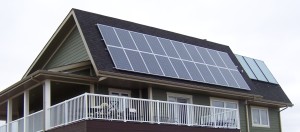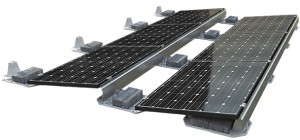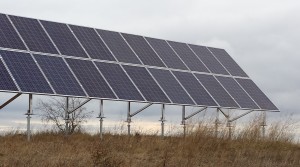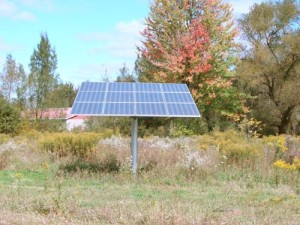Solar Power Mounting Options
1. Solar Trackers
![]()
Solar Trackers
A system that tracks the sun would be an ideal solution. However, a tracking system needs a massive mount to accommodate all the panels and a complex control system to make the tracking automatic. This makes the system expensive and the moving parts will require maintenance. Solar panels have come down in cost so much that it is far cheaper to buy more solar panels and put them on a mount that is fixed at an angle that provides a good compromise. Typically, for the 30% extra power production that you can get from a tracker, you could easily buy 50% more solar panels if you have the room for them. Solar trackers do make economic sense if you are short of space or if there is a reason to squeeze maximum production out of a fixed size of solar power system. This is the case, for example, in Ontario, Canada where the feed-in tariff pays a premium rate for systems up to 10 kW.
2. Roof Mounts

A roof clear of obstructions is best for mounting solar panels
The least expensive way to mount your system is directly on your roof. The mounting system fastens to the roof trusses and provides rails on which to mount the panels. The rails keep the panels a bit above the roof itself to provide ventilation for the panels. Solar panels are more efficient at lower temperatures, so ventilation is important. A simple roof mount is the way to go if you have enough south facing roof space at an angle approximately equal to your latitude. If this is a grid-tied system a lower angle can also work well since you usually produce a lot more power in the summer when the sun is higher in the sky. With grid-tied systems you can usually feed that extra power back for credits in the winter or sell it back to the utility.

Ballasted Solar Mount for a flat roof
If your roof is flat, or just doesn't have a steep enough slope, the roof mount angle can be adjusted to compensate for that. This adds some expense, but can significantly improve the production. Ballasted roof mounts, that don't require any roof penetrations, are also available for flat commercial roofs where the possibility of leaks is a big concern. Keep in mind that you also want your solar array to be free of any shading. Watch for dormers or trees or a roof on a more southerly part of the house that might shade your panels.
3. Ground Mounts

Ground mounted Solar Array
Perhaps you have no suitable roof space but lots of room on the ground. This is often the case on acreages and farms. A ground mounted array is the second most economical choice. A rack for the panels is set up at a suitable angle and mounted high enough above the ground to account for snow cover. The racks require more material than a sloped roof mount, so this adds some expense, as does the screw pile foundations. Ground mounted arrays have their advantages. You can more easily choose a good location with minimal shading. The array is also easily accessible for cleaning and clearing off any snow cover that accumulates on the panels.
4. Pole Mounts

Solar Panels on a Pole Mount
Another alternative for smaller solar power systems is one or more pole mounts. These are like a tracking mount but without the expense and complexity of the tracking system. Pole mounts are more expensive than ground mounts but can be manually adjusted for seasonal angles. It is also easier to select a good location for a pole mounted array. The limitation with a pole mount is that you don't want to mount too many panels on one pole. The array of panels is like a sail in the wind, so the larger the number of panels you mount on a pole, the more massive the pole and foundation will need to be. The other alternative is simply to use more pole mounts but each mount will need a pole and concrete foundation, with its attendant costs. Contact Us for help in choosing the best solar mounting system for your home.